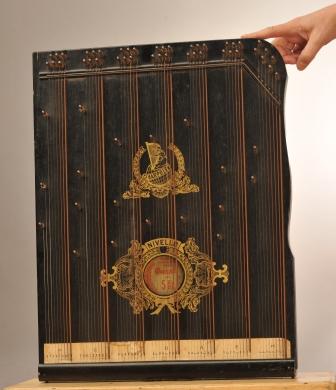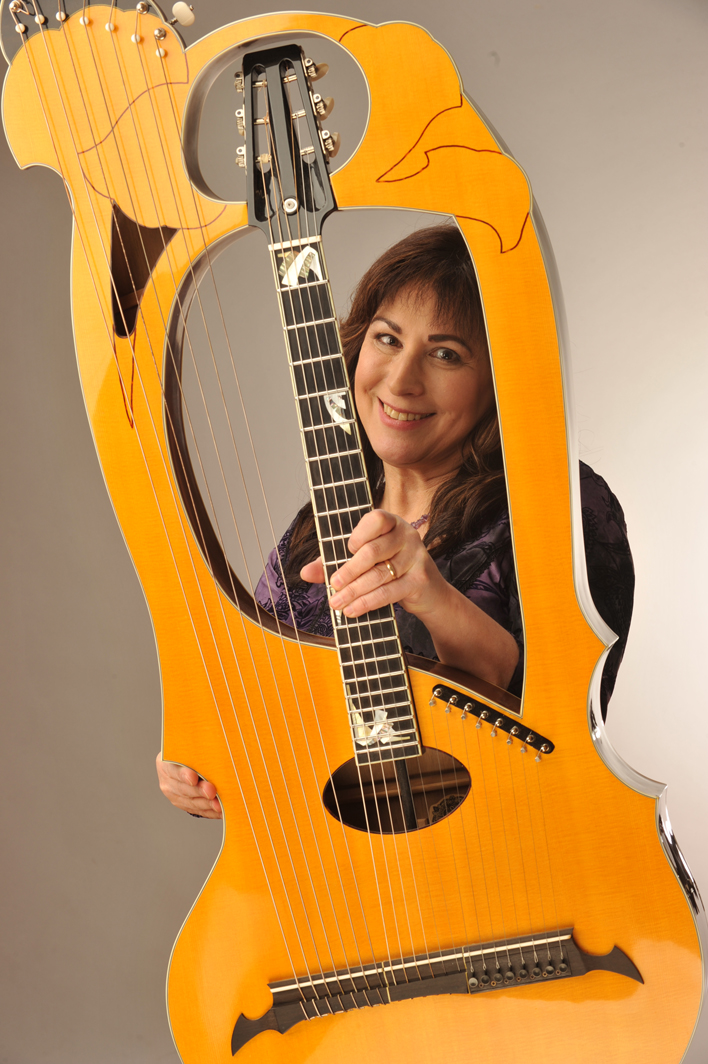| Home | |
 Karmalu Productions |
 |
On this page, you'll read about some of the more unusual instruments that Verlene plays!
| Swedish Nyckelharpa | Norwegian Hardingfele | Swedish Cittra | Harp Guitar |
| Swedish
Nyckelharpa Nyckel is the Swedish word for "key," and harpa is a word used for any stringed instrument before violins were used in Sweden. Like the hurdy-gurdy, the instrument has keys, but instead of being played with a wheel, it is played with a bow, like a violin or fiddle, so a nyckelharpa is a "keyed fiddle." The nyckelharpa has several keys that are pushed individually, moving a wooden dowel called a "tangent" to shorten the length of the string, producing a higher pitch. Each key on the modern nyckelharpa increases the pitch by one half step, making it a fully chromatic instrument. There are four bowed strings, with keys on the highest three. From the highest to lowest, the strings are tuned to A (440), middle C, G and the octave below middle C. This low C is used as a drone or the botton note in a chord. In addition to the four bowed strings, there are 12 chromatic strings that are set lower in the bridge so that the bow cannot reach them. These are "resonant" strings that vibrate sympathetically with each pitch. The nyckelharpa dates back to the 14th century, with a stone carving of one on the gates of Källunge chuch on Gotland, which is an island off the coast of Sweden. The earlier nyckelharpa was not fully chromatic and had fewer strings. The modern nyckelharpa was developed by August Bohlin in the early 1900s with improvements made by Eric Sahlström. Verlene's nyckelharpa was made in Sweden by luthier, Martin Westermark. |
Watch a video from a concert with To the Moon Watch videos from a concert with Neal Hellman |
| Norwegian
Hardingfele The hardingfele is known in the US as the Hardanger fiddle. The earliest hardingfele was made in 1651 in Hardanger, Norway. It is shaped pretty much like a violin, with 4 bowed strings, but has an additional 4 or 5 resonant strings that run through a hole in the bridge, and under the fingerboard. There is usually some rosmalling (Norwegian art form) inked into the body, and inlaid designs on the neck. There is also typically a stylistic lion carved on the head of the instrument. The bridge is less curved on the hardingfele than on the violin in order to facilitate playing two strings together in harmony. The hardingfele can be tuned in various ways -- sometimes the same as a fiddle, which is GDAE, but more often the bowed strings are tuned to ADAE. The 5 resonant strings are generally tuned to BDEF#A. It is also usually tuned up a step to a step and a half higher than concert pitch, so the "A" string (which is still referred to as A) might be a B or a C. Verlene's hardingfele was made in the US by Joe Baker. It was made on commission in the early 1990's for a somewhat elderly gentlemen who lived in Brooklyn. Her hardingfele has 5 resonant strings and is tuned a step and a half above concert pitch. |
|
| Swedish
Cittra Cittra is both Swedish and Norwegian for "zither." It is also known as a "harpeleik," also spelled "harpolek." It is strummed with a pick or a "plectrum" and is tuned in chords so that each group of strings includes all the notes in the triad. Each is tuned to either a major or a minor chord. The range of notes within each chord is 3 and a half to 4 octaves. It is laid flat on a table or other surface, and can be played standing or sitting. One hand strums the chord and the other hand damps that chord at the same time a new chord is strummed. It can be strummed through all the strings in each chord, or just up to a particular pitch in order to create melodies. Likewise, one can strum starting in the middle of the chord to avoid the lowest bass notes. Verlene's 7 chord cittra was an Ebay find, and the age and origins are unknown. |
 |
| Harp Guitar The harp guitar has most likely descended from the theorbo which is a long-necked lute developed in the late 16th century in response to a need for more bass strings. Composer and balladeer, Sven Scholander (1860 - 1936) of Stockholm, Sweden popularized the "false" Swedish lute which was tuned like a guitar rather than the lute, and had additional harp-like bass strings. Harp guitars just like the theorbo were played throughout Europe in the late 1800s and early 1900s and were used both as a solo instrument and as an ensemble instrument in mandolin orchestras around the world. Another Scandinavian connection is that the harp guitar's introduction in the US in teh early 1900s was made by a guitar builder from Norway, Chris Knudsen, and the Larson brothers from Sweden, who build the "Dyer" model harp guitars. Verlene's harp guitar was built by Belgian luthier, Beniôt Muelle-Stef, which he designed after the early 1900s Italian luthier, Luigi Mozzani. Verlene's "Mozzani" style harp guitar has 21 strings -- with 6 regular guitar strings, 7 bass strings, and 8 treble strings. The bass strings are tuned diatonically from the D below the lowest guitar E string down to the E an octave below. The treble strings are also tuned diatonically from the E at the 12th fret of the highest guitar string up to the E an octave higher. The original Mozzani harp guitars had fewer bass strings and no treble strings. |
 |